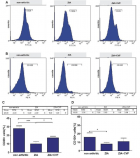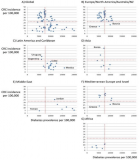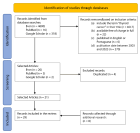About Saints Cyril and Methodius University of Skopje
Saints Cyril and Methodius University of Skopje
Articles by Saints Cyril and Methodius University of Skopje
The body composition analysis: Differences between students and the trend of their change
Published on: 22nd March, 2018
OCLC Number/Unique Identifier: 7493653979
Anthropometric characteristics, represent one of the most important subsystems within the “system” of man, and which can be in affected by physical exercises in the direction of the desired transformation. Very often the anthropometric parameters (height and weight) are used in the assessment of the morphological status of an individual, and on the basis of the results of Body Mass Index (BMI) bring certain estimates and conclusions. BMI as a statistical measures, is used in many public health campaigns as an approximate measure of the ideal body mass and the degree of nutrition of a population. The main goal of the research was to determine and analyze differences in BMI parameters between male and female students, aged 18±0.5 years, and determine the trend of changes. Using the T-test module, the obtained results confirmed that there are statistically significant differences in body height (t=8,17; p<0.001) and body weight (t=5,29; p<0.001), while in BMI values there are not statistically significant differences (t=-0.68, p>0.001). Based on BMI values, a positive trend of somatic changes of both poles is evident.
C-reactive protein is associated with ventricular repolarization dispersion among patients with metabolic syndrome
Published on: 27th June, 2019
OCLC Number/Unique Identifier: 8192802745
Background: An increasing body of evidence indicates that inflammatory activation profoundly impacts the electrophysiological properties of cardiomyocytes. A marker of systemic inflammation such as C-reactive protein(CRP), is associated with all parameters of the Mtabolic syndrome(MetS) and that may result in adverse cardiac events via multiple effects, ultimately resulting in a prolongation of Action Potential duration (APD), and thereby of the QTC (QT corrected) interval on ECG.
Objective: We sought to investigate the influence of CRP levels on the prevalence of prolonged QT-dispersion and prolonged Tpeak-Tend –dispersion in the patients with MetS.
Methods: We conducted a multicenter observational cross-sectional study. The study population consisted of 200 patients with MetS, stratified in two groups:103 participants (50 females and 53 males) with level of CRP>3mg/l, and 97 participants (47 females and 50 males) with level of CRP<3mg/l), who attended outpatient visits at general cardiology Health Care Clinics during 1 calendar year. For the analysis of the ECG, we performed a manual measurement of the values using a digital caliper with measuring range of 0-150 mm, 0.01 mm resolution, and 0-100 ± 0.02 mm accuracy. QT interval dispersion was obtained by the difference between the maximum and the minimum QT intervals found in the 12-lead electrocardiogram. The Tpeak-Tend interval was obtained from the difference between QT interval and QTpeak interval.
Results: Prolonged QTC. dispersion, was found in 51.4% of participants with level of CRP>3mg/l and in 32.9% of with level of CRP<3mg/l, the differences were statistically significant. (p=0.004). The results showed that 51.4% participants with level of CRP>3mg/l had a prolonged Tpeak-Tend interval, and 32.9% of participants with level of CRP<3mg/l had prolonged Tpeak-Tend interval. Difference were statistically significant.( p=0.04). There were significant association of increased levels of CRP and QTC-dispersion (OR = 2.486, 95% CI 1.389-4.446).There were significant association of increased levels of CRP with Tpeak-Tend Dispersion (OR=2.239,95%CI 1.262-3.976). Prolonged QTC max. Interval OR=2.236,%CI 1.246-4.014),Prolonged Tp-Te-interval. (OR=2.367, 95%CI 1.327-4.222), also there were significant association of increased levels of CRP with BMI. (OR=1.154, 95%CI 1.095-1.227) and significant association of increased levels of CRP with presence of uncontrolled glicemia.(OR=1.779, 95%CI 1.014-3.12).
Conclusion: We think we proved the hypothesis that patients with MetS and high level of CRP have higher prevalence of QT- dispersion and Tpeak-Tend dispersion than patients with MetS and lower level of CRP. These findings have both epidemiological and clinical relevance, also these findings might lend further insight into potential mechanisms by which MetS is associated with adverse cardiac events.
Control of arterial hypertension and risk of new-onset of atrial fibrillation in patients with metabolic syndrome
Published on: 10th March, 2022
Background: An association between Atrial Fibrillation (AF) and Metabolic Syndrome (MS) a constellation of abnormalities (high blood pressure, hyperglycemia, dyslipidemia, and abdominal obesity), has been demonstrated. There have been many studies that have shown that elevated blood pressure (BP), was significantly associated with an increased risk of AF. It is uncertain whether maintaining the optimal BP levels can prevent AF in the patients with MS categorized as ‘high-risk’ patients.Objective: The aim of this study was to evaluate the influence of control of BP on the occurrence of new-onset atrial fibrillation in patients with Metabolic Syndrome.Methods: Into this observational study, was enrolled 435 consecutive patients (210 males and 225 females) aged 45-79 years who fulfilled criteria for MS. Participants were selected among primary and secondary care patients, who were receiving ongoing care for arterial hypertension in the period from November 2018 till November 2021. The study was conducted at outpatients in 5 Health Care Clinics (3 Secondary Health Care Clinics and 2 Primary Health Clinics). Patient were categorized according to their BP levels as Group 1-patients with controlled BP, {(patients aged < 65 years Systolic Blood Pressure (SBP) of 120 - 130 mmHg, patients aged ≥ 65 years SBP of 130 - 139 mmHg)} and Diastolic Blood Pressure (DBP), {(patients aged < 65 years of < 80 mmHg. but not < 70 mmHg; patients aged ≥ 65 years of 85 - 89 mmHg)}, or Group 2-patients with uncontrolled BP(> 130/80 mmHg),and in patients aged ≥ 65 years BP (≥ 140/90 mmHg ). Results: New-onset of AF, was more frequent in participants with uncontrolled BP, respectively (34.7% vs. 19.5%, p = 0.009).Patients with uncontrolled BP have more frequent persistent AF (15.2% vs. 0.04%) and permanent AF (0.08% vs. 0.02%), whereas there was not significant changes between groups in relation to frequency of paroxysmal AF, respectively (12.8% vs. 10.9%, p = 0.29). There was observed significant association of uncontrolled BP with: increased frequency of AF (OR = 2.193; 95% CI 1.390 - 3.439), persistent AF (OR = 3.931; 95% CI 1.771 - 8.084), permanent AF (OR = 4.138; 95% CI 1.383-12.381), LA. Dimension ≥ 2.2 cm/m2 (OR = 2.089, 95% CI 1.330 - 3.252), BMI (OR = 5.226, 95% CI 3.155 - 8.659) and 5-risk factors for MS, respectively (OR = 2.998, 95% CI 1.833 - 4.901).Conclusion: Optimal BP levels, can reduce the frequency of new-onset AF in patients with MS categorized as ‘high-risk’ patients. Uncontrolled BP was associated with an increased risk of both subtypes of AF (persistent and permanent) in the patients with MS categorized as ‘high-risk’ patients.

HSPI: We're glad you're here. Please click "create a new Query" if you are a new visitor to our website and need further information from us.
If you are already a member of our network and need to keep track of any developments regarding a question you have already submitted, click "take me to my Query."

























































































































































